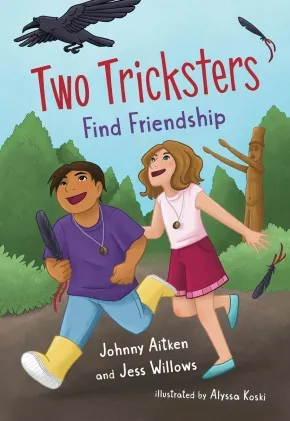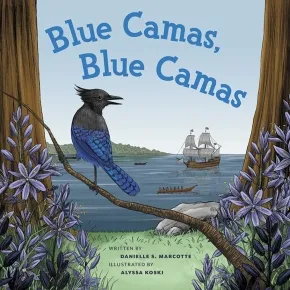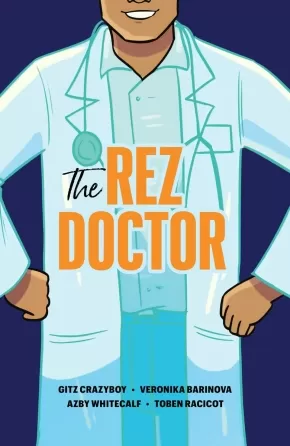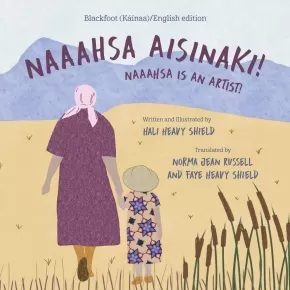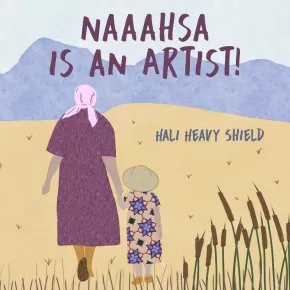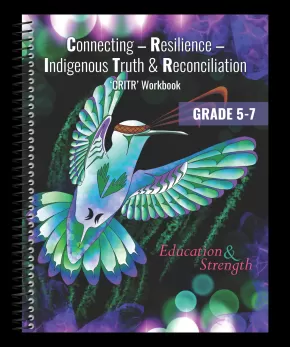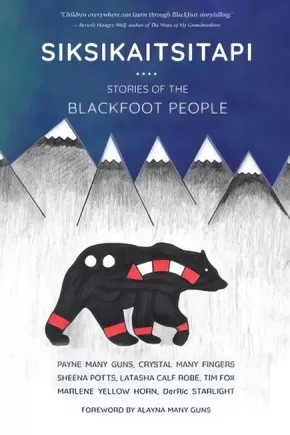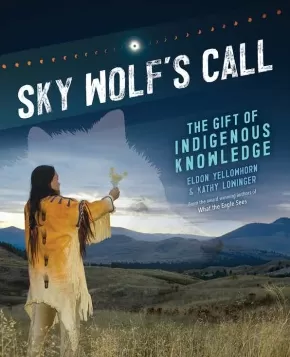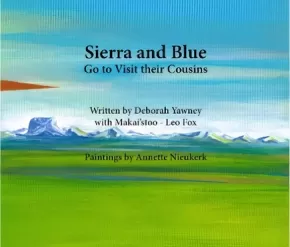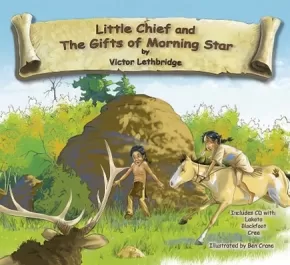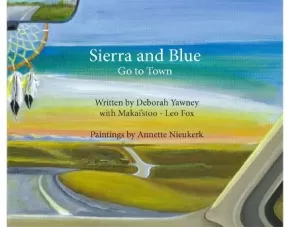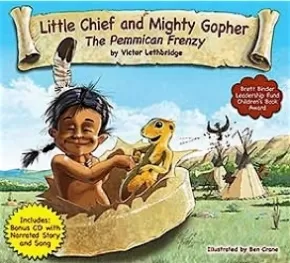
Blackfoot Confederacy (Siksikaitsitapi)
1
-
15
of
15 Results;
Sort By
Johnny et Jessie reçoivent un message de Corbeau
$9.95
Format:
Paperback
Text Content Territories:
Indigenous Canadian; First Nations; Salish; Coast Salish;
ISBN / Barcode: 9781459844599
Synopsis:
Synopsis:
Aux yeux de Jessie et Johnny, leur amitié est simple.
Jessie et Johnny sont inséparables depuis que Jessie est déménagée dans leur petite ville insulaire, au cours des vacances d’été. Mais alors qu’ils débutent ensemble leur quatrième année, l’année scolaire s’annonce mouvementée, quand des pressions de l’extérieur et des différences dans leur vie familiale viennent menacer leur amitié. Jessie mène une vie confortable et n’a jamais à s’inquiéter d’argent, tandis que Johnny vit avec son père et sa belle-mère dans la réserve en dehors de la ville. Grâce aux conseils de Corbeau et de leur professeur spirituel, Steven, les deux amis comblent les lacunes entre eux et apprennent à compter l’un sur l’autre, malgré leurs soucis familiaux et leurs différences culturelles.
Également disponible sous le titre Two Tricksters Find Friendship en anglais.
Educator Information
Recommended for ages 6 to 8.
This book is available in English: Two Tricksters Find Friendship.
Additional Information
104 pages | 5.25" x 7.62" | Paperback
Algonquin Legacy
$16.99
Format:
Paperback
Text Content Territories:
Indigenous Canadian; First Nations; Anishinaabeg; Algonquin; Blackfoot Confederacy (Siksikaitsitapi); Cree (Nehiyawak); Mi'kmaq;
ISBN / Barcode: 9781459756304
Synopsis:
Synopsis:
This thrilling conclusion to the Algonquin Quest series ends the Anishinaabe peoples' fifty-year odyssey from the east coast of Turtle Island to the mysterious shadow of the Rocky Mountains.
Algonquin Legacy starts out fifteen years after the Battle of Crow Wing River where the combined allies of the Anishinaabe had fought the powerful Lakota nation in the Lakota homelands. The battle ended abruptly when there was a solar eclipse - an actual event that took place on July 16, 1330, from 1:03 to 3:10 p.m., in the area where they were fighting. The warriors on both sides thought it was an omen and retreated.
When the Anishinaabe returned to their village the decision was made to go towards the western sun to settle. This decision came at great cost to the surviving family of the late Omàmiwinini (Algonquin) leader Mahingan. His son, daughter, and the great Mi'kmaq warrior Crazy Crow, went to the west with the Anishinaabe. Mahingan's wife and nephews, along with their wives, friends, and Mahigan's brother, Mitigomij, the greatest warrior of them all, who was also a shape shifter, travelled back to their homelands along the Kitcisìpi Kitchi (Ottawa River), splitting up the very strong family.
Educator Information
Recommended for ages 12 to 15.
This is the fourth book in the Algonquin Quest series.
This novel continues on in the tradition of the previous three with Native languages in the vernacular, teachings about the culture of that era, hunting practices and how they lived day to day. Life before the Europeans, before the Four Horsemen of the Native Apocalypse came into their lives; Disease, Alcohol, Guns and Religion.
Additional Information
318 pages | 5.50" x 8.50" | Paperback
Two Tricksters Find Friendship
$8.95
Format:
Paperback
Text Content Territories:
Indigenous Canadian; First Nations; Salish; Coast Salish;
ISBN / Barcode: 9781459839281
Synopsis:
Synopsis:
Friendship can overcome any obstacle.
To Jessie and Johnny, their friendship is easy.
Jessie and Johnny have been inseparable ever since Jessie moved to the small island town during summer break. But as they begin fourth grade together, the new school year gets off to a rocky start when outside pressures and differences in their home lives threaten their friendship. Jessie lives comfortably and never worries about money while Johnny lives with his father and stepmother on the reserve outside of town. With guidance from Raven and spiritual teacher, Steven, the two friends bridge the gaps between them and learn to lean on each other through family troubles and cultural differences.
Reviews
"From the first paragraph, I was hooked. This is a beautiful story about friendship, family and community. The characters take us on adventures of discovering the connection to land, animals and history. Their friendship helps us understand how we care for each other on this journey of truth and reconciliation. My new favorite book!”— Monique Gray Smith, award-winning author of My Heart Fills With Happiness
“Set in the peace of a rural coastal community, this thoughtful and inspiring book creates space not just for playful adventure but reflection, curiosity and learning. Young Jessie and Johnny demonstrate the power of true friendship to bridge cultural difference, and their story shows us that wisdom comes from many kinds of teachers—the land, trickster Raven, Elders and, importantly, one another. Well-paced and charmingly illustrated, this book draws you into a beautiful world among trees and berry bushes, at the beach and the Bighouse, and it teaches that approaching each other with openness, support and respect allows for the discovery of many gifts.”— Amy Reiswig, reviewer, writer, editor
Educator & Series Information
Recommended for ages 6 to 8.
This book is part of the Orca Echoes series.
Key features:
- Two friends face the fourth grade together while learning to overcome cultural prejudices. Reconciliation is exemplified by a friendship between a non-Indigenous child and an Indigenous child.
- The authors use fictional versions of their younger selves to reimagine what it would be like if they met as children today.
- Extended family are shown as key supporters for Johnny and Jessie, and positive relationships with a grandmother, aunties, and a cousin are depicted.
- Coast Salish culture is celebrated by author Johnny Aitken’s own experiences and teachings.
- An Indigenous character, who identifies as 2Spirit, acts as a role model and educator to the two friends.
Reading Levels:
Fountas & Pinnell Text Level Gradient: R
Lexile measure: 720L
Guided Reading Level: R
This book is available in French: Johnny et Jessie reçoivent un message de Corbeau.
Additional Information
96 pages | 5.25" x 7.62" | Paperback
Blue Camas, Blue Camas (PB)
$14.95
Format:
Paperback
Text Content Territories:
Indigenous Canadian; First Nations; Salish; Coast Salish; Songhees (Lekwungen);
ISBN / Barcode: 9781772035247
Synopsis:
Synopsis:
The captivating story of how the Blue Camas, a flower that has been cultivated on Canada’s west coast since time immemorial, came to symbolize the meeting of two contrasting ways of life and the perseverance of traditional knowledge against all odds.
Blue Camas, Blue Camas tells the story of a flower that is native to the Northwest Coast of North America. For thousands of years, it has been considered a sacred and valuable plant by the Indigenous Peoples of this region, who harvested and traded Blue Camas bulbs all along the west coast. At the height of this period, meadows would come alive with the bright wildflowers, which would attract dozens of species of butterflies and birds, and entire villages would work together to harvest the plant and ensure its continued growth.
When Europeans arrived and began to colonize the land, they did not see the value of the Blue Camas plant, and in fact saw the meadows where the plant had been harvested as ideal terrain to grow their own crops. The story takes place at the point of contact between a Lkwungen community and a group of Irish settlers, who see the land in very different ways.
This beautifully illustrated picture book is an ode to a way of life that was threatened and nearly destroyed through miscommunication and colonization. It also raises awareness for food rights, biodiversity, and the preservation of ecosystems, offering children and teachers the opportunity to discuss these important themes in an open and constructive way.
Reviews
"Blue Camas, Blue Camas is a captivating story revealing the overlooked history of colonial contact and its impact on Indigenous communities. Through vivid storytelling and diverse voices, it emphasizes land stewardship, cultural heritage, and fostering empathy, making it a valuable resource for children.”—Samantha Beynon, author of Oolichan Moon
“A beautiful story and an important narrative about the timeline of colonial contact . . . I am happy to share this book with my children.”—Sen’ákw, Senaqwila Wyss, Squamish Nation ethnobotanist
“Danielle S. Marcotte offers a rich, historical perspective of the amazing Blue Camas plant through the eyes of a First Nations family and a settler family.”—Teoni Spathelfer, Heiltsuk author of the Little Wolf Series
“This beautiful story weaves together a rich and important narrative. Family, nature, and the village are all intertwined, with the camas at the centre of it all. So simple and yet so poignant and true!”—Robert "Lucky" Budd, co-author (with Roy Henry Vickers) of the Northwest Coast Legends Series and A Is for Anemone: A First West Coast Alphabet
Educator Information
Recommended for ages 4 to 8.
Additional Information
48 pages | 9.00" x 9.00" | Paperback
The Rez Doctor
$22.95
Artists:
Format:
Paperback
Text Content Territories:
Indigenous Canadian; First Nations; Blackfoot Confederacy (Siksikaitsitapi);
ISBN / Barcode: 9781553799245
Synopsis:
Synopsis:
In this uplifting story, a young Indigenous man overcomes hardship to fulfill his dream of becoming a doctor.
Young Ryan Fox gets good grades, but he’s not sure what he wants to be when he grows up. It isn’t until he meets a Blackfoot doctor during a school assembly that he starts to dream big.
However, becoming a doctor isn’t easy. University takes Ryan away from his family and the Siksikaitsitapi community, and without their support, he begins to struggle. Faced with more stress than he’s ever experienced, he turns to partying. Distracted from his responsibilities, his grades start to slip. His bills pile up. Getting into med school feels impossible. And now his beloved uncle is in jail. Can Ryan regain his footing to walk the path he saw so clearly as a boy?
This inspiring graphic novel for young adults is based on a true story.
Awards
- NCSS-CBC Notable Social Studies Book 2025 Winner
- CBC Young Adult Favorites 2025 Winner
- 2025 Next Generation Indie Book Award (Graphic Novel) Winner
Reviews
“Readers will root for Chase as he struggles with realistic problems like failing grades, acute stress, near-alcoholism, bills, and suddenly becoming a dad….The Rez Doctor is an uplifting and realistic narrative of achieving your dreams and giving back to your community.” — Youth Services Book Review
“…this graphic novel would be a good addition to any collection.” — School Library Journal
Educator Information
Recommended for ages 12+
Themes, Subjects, and Big Ideas: YA Fiction, Graphic Novels, Coming of Age, Careers, Occupations, New Experiences.
Fountas & Pinnell (F&P) Level: Z
Additional Information
64 pages | 6.50" x 10.00" | Paperback
Naaahsa Aisinaki! / Naaahsa is an Artist!
$21.95
Format:
Hardcover
Text Content Territories:
Indigenous Canadian; First Nations; Blackfoot Confederacy (Siksikaitsitapi); Kainai (Blood);
ISBN / Barcode: 9781772603477
Synopsis:
Synopsis:
Naaahsa says art is a language everyone understands. Sometimes we make art together. We draw, we bead, we sing. Sometimes Naaahsa tells stories in Blackfoot. I even get to go with her to see her art show at the National Gallery. Naaahsa is famous for her art, but I love her hugs best!
Naaahsa is an Artist! is a celebration of art, artists, and Indigenous women artists in particular. Each page comes to life with bold patterns, shapes, and Naaahsa's encouraging words that may inspire young readers to want to make art themselves.
Educator Information
Recommended for ages 6 to 8.
Dual-language edition in English and Blackfoot: Kainai Nation
Blackfoot translation by Norma Jean Russell and Faye Heavy Shield.
This book is available in English: Naaahsa is an Artist!
Additional Information
24 pages | 8.50" x 8.50" | Hardcover
Naaahsa Is an Artist!
$21.95
Format:
Hardcover
Text Content Territories:
Indigenous Canadian; First Nations; Blackfoot Confederacy (Siksikaitsitapi); Kainai (Blood);
ISBN / Barcode: 9781772603460
Synopsis:
Synopsis:
Naaahsa says art is a language everyone understands. Sometimes we make art together. We draw, we bead, we sing. Sometimes Naaahsa tells stories in Blackfoot. I even get to go with her to see her art show at the National Gallery. Naaahsa is famous for her art, but I love her hugs best!
Naaahsa is an Artist! is a celebration of art, artists, and Indigenous women artists in particular. Each page comes to life with bold patterns, shapes, and Naaahsa's encouraging words that may inspire young readers to want to make art themselves.
Reviews
“What a marvelous and sparkling read. How blessed are we to have Naaahsa’s wisdom for how inspiration is everywhere and, if you welcome and embrace it, the magic of the world is yours to celebrate your way in any way you wish. Thank you, Hali Heavy Shield, for sharing Naaahsa’s warmth and love. Every page feels like a hug from home.” — Richard Van Camp, author of Little You and We Sang You Home
“This book is sure to be a hit. As seen through the eyes of a grandchild, Naaahsa is an Artist! conveys the healing power of art and the importance of taking up space in institutions that have not welcomed Indigenous Peoples in the past.” — Nancy Cooper, First Nations Consultant for the Southern Ontario Library Services and coordinator for First Nation
“I love the grandmother/granddaughter relationship here and I love how proud the little girl is of her grandma. It’s a book I can relate to as I had a close relationship with my grandmother.” — Jodie Callaghan, author of Ga’s/The Train
Educator Information
Recommended for ages 6 to 8.
This book is available in a dual-language format: Naaahsa Aisinaki! / Naaahsa is an Artist!
Additional Information
24 pages | 8.50" x 8.50" | Hardcover
Connecting – Resilience – Indigenous Truth & Reconciliation ‘CRITR’ Workbook: Grade 5 - 7
$29.95
Artists:
Format:
Coil Bound
Text Content Territories:
Indigenous Canadian; First Nations; Inuit; Métis;
ISBN / Barcode: 9781990448348
Synopsis:
Synopsis:
CRITR provides dozens of lessons and 100s of questions covering important topics including: Indigenous Canadian History, Residential Schools, Indigenous Contributions past and present, Treaties, and Indigenous Days of Recognition in Canada.
This book is a collection of parts of the history of the Indigenous Peoples in Canada and of the process of reconciliation. It is designed to educate all children and youth -- our future leaders -- about Indigenous history and current events. It is intended to give a better understanding and to positively contribute to reconciliation.
Together, we must consider the past, the present, and the future in our efforts to better ourselves and future generations.
This book provides a wealth of high-quality articles and learning activities, consisting of units and lessons that can be used by anyone -- teachers, parents, students, business professionals -- who may have little or no prior knowledge or understanding of Indigenous Peoples or subjects.
In this book, you will meet real Indigenous Peoples speaking out and sharing their stories and their firsthand experiences, and you will clearly hear their passion for reconciliation.
This book is unique. The stories told within its covers are unique, just like everyone working through their own journey of understanding and doing their small part towards reconciliation.
“We need to pursue reconciliation consistently and passionately. Education has gotten us into this mess, and education will get us out. We see this as our challenge and our hope.” -The Honourable Senator Murray Sinclair
Educator Information
Recommended for grades 5 to 7.
CRITR Workbook Features
- Indigenous knowledge from different Indigenous Peoples and Indigenous perspectives.
- Dozens of lessons covering important topics including Residential Schools, Treaties, and Indigenous Contributions.
- Beautiful original art on the cover and throughout the book.
- An Indigenous worldview expressing people's need to develop themselves and their children, in a way that addresses their spiritual, physical, emotional, and mental gifts.
- An approach to the teaching and healing process that is interconnected and cyclical in nature.
- An introduction to readers of the concept of a "sacred circle," also known as a medicine wheel, as well as First Peoples' principles of learning in general terms.
- Words of encouragement.
- A balance between too much and too little content.
- Information and a layout to inform and inspire without overwhelming the teacher or the student, in the classroom or at home.
- Fresh insights and learning activities for key Indigenous events that are celebrated annually in schools and communities across the Nation.
- Critical thinking questions to inspire new learning.
- Activities for individuals and groups.
- The font in the grade 5 to 7 book is ideal for young readers ( Arial 13.5-point font). Additionally, the grade 5 to 7 book features shorter sentence structure for easy reading and comprehension.
- A few activities and lessons featured in the grade 8 to 12 resource have been changed or removed in the grade 5 to 7 book due to the maturity level of the subject matter.
- Grade-level appropriate word choices to help with improved vocabulary.
How is the CRITR workbook organized?
Each lesson follows this pattern:
- An easy-to-read lesson that may be read in under 5 minutes
- A vocabulary focus called Word Power that defines key words from the lesson
- A set of questions easily answered from the reading
- A Critical Thinking section is included to enhance learning
- Sprinkled throughout the CRITR Workbook are relevant individual and group activity recommendations.
Additional resources are identified throughout the pages with links, including information about how to connect with the Indigenous authors and artists.
Activities, colouring, and word search pages may be downloaded for free. An answer key is included at the end of the book.
What will students learn from this resource?
- Reconciliation is about change, justice, respect, and re-building the relationships between the Indigenous and non-Indigenous Peoples in Canada
- Indigenous History of Canada
- Empathy that comes from understanding and being educated
- Knowledge about important and sensitive topics, including stories told by Indigenous authors about what occurred at residential schools. It is important to know these stories of assimilation
- Capacity for intercultural understanding, empathy, and mutual respect as prescribed specifically in CTA #63
Educator Information
For grades 5 to 7.
A $5 per book discount is applied to a purchase of 10 or more books.
This book is available in French: Connexion - Résilience - Vérité et réconciliation autochtones Ressource - 5e à 7e année
Additional Information
176 Pages | 9" x 11.5" x 0.5" | Spiral Bound
Siksikaitsitapi: Stories of the Blackfoot People
$37.50
Text Content Territories:
Indigenous Canadian; First Nations; Blackfoot Confederacy (Siksikaitsitapi); Piikani (Peigan, Aapatohsipikani); Kainai (Blood); Siksika (Blackfoot);
ISBN / Barcode: 9781988824833
Synopsis:
Synopsis:
In Siksikaitsitapi: Stories of the Blackfoot People, seven authors share their stories that come from both from legend and from their personal experiences, with many of the stories in both Blackfoot and English languages. The book is illustrated with beautiful full-colour pictures and photos which help convey these stories from Blackfoot traditional and contemporary traditions and cultures. The Blackfoot Confederacy is made up of the Siksika, Kainai, Piikani, and Amskapi Piikuni Nations of Southern Alberta and Montana.
Payne Many Guns' story captures the ways the Blackfoot People live in harmony with the land, animals, and stars in their traditional lands.
Crystal Many Fingers tells a delightful, modern story about animals, their gifts, and why they were put on Earth.
Sheena Potts' story beautifully illustrates the many ways love is alive in Blackfoot traditions and culture.
Tim Fox tells a humerous story about mice who are having a celebration that the raven Napi and a group of dogs want to join.
Marlene Yellow Horn shares her personal story of the teachings she learned as a child about the Elders' traditional and sacred knowledge.
DerRic Starlight tells the tale of Morning Star's diverse and loving family life.
Foreword is by Alayna Many Guns.
Educator & Series Information
The publisher recommends this title for grades 6 to 12, but these stories will appeal to children of all ages.
This book is part of the Indigenous Spirit of Nature series.
"These Blackfoot children’s book chapters share common knowledge stories which have been shared to our authors. Common knowledge includes everyday lessons and norms. The book provides us with an opportunity to reclaim our truths. In the past, sitting with an Elder and listening to traditional stories of the stars, the animals, Napi, and our purpose was a great gift. Today, this is more important than ever. Elders gift us with purpose, strength, knowledge, and love." - Alayna Many Guns, from the foreword
Additional Information
144 pages | 6.00" x 9.00" | Colour illustrations | Paperback
Sky Wolf's Call: The Gift of Indigenous Knowledge
$16.95
Format:
Paperback
Text Content Territories:
Indigenous Canadian; Indigenous American;
ISBN / Barcode: 9781773216294
Synopsis:
Synopsis:
From healing to astronomy to our connection to the natural world, the lessons from Indigenous knowledge inform our learning and practices today.
How do knowledge systems get passed down over generations? Through the knowledge inherited from their Elders and ancestors, Indigenous Peoples throughout North America have observed, practiced, experimented, and interacted with plants, animals, the sky, and the waters over millennia. Knowledge keepers have shared their wisdom with younger people through oral history, stories, ceremonies, and records that took many forms.
In Sky Wolf’s Call, award-winning author team of Eldon Yellowhorn and Kathy Lowinger reveal how Indigenous knowledge comes from centuries of practices, experiences, and ideas gathered by people who have a long history with the natural world. Indigenous knowledge is explored through the use of fire and water, the acquisition of food, the study of astronomy, and healing practices.
Reviews
"An authoritative tribute to Indigenous knowledge systems that's a must-have for every library and classroom." - Kirkus Reviews
“Sky Wolf’s Call has an astoundingly broad scope introducing Indigenous Traditional Ecological Knowledge (TEK) in North America from time immemorial to the current day … This fast paced celebration of Indigenous innovation and technology is riveting.” - The British Columbia Review
Educator Information
Interest Age: 11+
Grade: 6+
Reading Age: 11+
A Junior Library Guild Gold Standard Selection
Table of Contents
Author’s Note
1: Sky Wolf’s Call: The Gift of Indigenous Knowledge: Foundational ideas behind Indigenous Knowledge and the importance of retaining, maintaining, and learning this sacred knowledge.
2: Water Knowledge Ways: Water links us all and is sacred. Indigenous people have fought to protect the gift of water from harm, and the critical role it has played in transportation, agriculture, irrigation, and food.
3: Fire and Smoke Knowledge: Fire and smoke are great gifts, including the burning of tobacco. In sacred ceremonies, smoke connects our breath with the heavens. Fire cooks our food, helps grow our crops, and even keeps our waters clean. Cultural burns are used to benefit the land.
4: Indigenous Knowledge and Food Security: Sharing, growing, and receiving food with family, community, and visitors is both an honour and a tradition. By understanding the traditional practices of salmon fishing, clam gardens, planting and harvesting certain crops, or hunting buffalo, Indigenous Peoples have respected what Mother Earth has to offer.
5: Healing Knowledge Ways: The use of the medicine wheel and the sweat lodge have been used over centuries and still help sick and troubled people. Games such as lacrosse and chunkey have helped in building individual strength and community spirit. And braiding together Indigenous healing and western science has opened new learning opportunities.
6: Sky Knowledge: From the earliest Indigenous astronomers to modern astrophysicists, these sky watchers have studied the sacred gifts of the sky: the sun, moon, planets, and stars that have produced maps, calendars, beliefs about how to govern, and even directions for building homes.
7: Keeping the Knowledge: Indigenous People hold oral narratives in high esteem because that was the way knowledge passed from one generation to the next. People in North America recorded important events with symbols, pictographs (paintings), and petroglyphs (carvings). Language Keepers and Knowledge keepers are making sure that Indigenous knowledge is never forgotten.
8: Sky Wolf’s Call: Indigenous knowledge is based on the idea that this world is a gift. Understanding the idea of connections (the skies with the earth, people with animals, the practical with the spiritual) is an important lesson with the challenges of climate change, pandemics, and wars. The wisdom of Indigenous Knowledge can help the whole world.
Thanks and Acknowledgments
Glossary
Selected Reading
Sources and Contacts
Additional Information
120 pages | 7.50" x 9.25" | Paperback
Sierra and Blue Go to Visit their Cousins
$14.99
Artists:
Format:
Paperback
Text Content Territories:
Indigenous Canadian; First Nations; Blackfoot Confederacy (Siksikaitsitapi); Kainai (Blood);
ISBN / Barcode: 978-0-986-7817-2-8
Synopsis:
Synopsis:
In Sierra and Blue Go to Visit their Cousins, the children go to visit their cousins at their home near Old Agency in a different area of the Blood Reserve. The children play with their cousins and enjoy a meal with their family and friends.
The Blackfoot language focus for this book is animals.
The stories incorporate some English and Blackfoot words. There is also a pronunciation guide included in the last pages of each book.
Each of the unique images in the Sierra and Blue series are painted in acrylic on canvas and depict a realistic portrait of the character and beauty of Southern Alberta.
Educator & Series Information
Recommended for ages 8 to 12.
This book is the third book in the Sierra and Blue series.
Includes a Blackfoot Glossary at the back of the book.
Additional Information
38 pages plus cover | 8.5" x 10"
Little Chief and The Gifts of Morning Star
$21.95
Artists:
Format:
Hardcover
Text Content Territories:
Indigenous Canadian; First Nations; Sioux; Lakota; Cree (Nehiyawak); Blackfoot Confederacy (Siksikaitsitapi);
ISBN / Barcode: 9780986673818
Synopsis:
Synopsis:
This book introduces a young girl and her horse into Little Chief’s life. Their adventure takes them on an exquisite journey which transforms her loss and grieving into self-discovery and resilience through a new found hope.
Educator Information
This story takes readers of all ages on an adventure that teaches them about the circle of life. Singing Feather joins Little Chief who helps transform her loss and grieving of a treasured friend, in this case, Silver Sage her old and heroic horse, into self-discovery and resilience by finding a new hope.
The book comes with an attached CD of narration in English, Cree, Blackfoot and Lakokta as well as a song.
Additional Information
34 pages | 10.00" x 9.25"
Sierra and Blue Go to Town
$14.99
Artists:
Format:
Paperback
Text Content Territories:
Indigenous Canadian; First Nations; Blackfoot Confederacy (Siksikaitsitapi); Kainai (Blood);
ISBN / Barcode: 978-0-9867817-1-1
Synopsis:
Synopsis:
In Sierra and Blue Go to Town, the children travel to Lethbridge with their grandparents for the day and take part in many fun and healthy activities like visiting the library and going to the local pool.
The Blackfoot language focus for this book is foods.
Educator & Series Information
Recommended for ages 8 to 12.
This book is the second book in the Sierra and Blue series.
Includes a Blackfoot Glossary and information on the Blackfoot Alphabet at the back of the book.
Additional Information
34 pages plus cover | 8.5" x 10"
Little Chief and Mighty Gopher: The Pemmican Frenzy
$21.95
Artists:
Format:
Hardcover
Text Content Territories:
Indigenous Canadian; First Nations; Blackfoot Confederacy (Siksikaitsitapi); Cree (Nehiyawak); Sioux;
ISBN / Barcode: 9780986673801
Synopsis:
Synopsis:
Discover what happens when a young boy’s friendship with a gopher turns everyone’s life upside down!
Written by Indigenous author Victor Lethbridge and beautifully illustrated by Ben Crane, Little Chief and Mighty Gopher: The Pemmican Frenzy tells the story of a young boy who finds friends and acceptance in unexpected places. This is a funny, heartfelt story of hope, empowerment and determination suited to young readers, the young at heart and those who struggle with bullying and rejection.
This book has already become a Canadian bestseller and winner of numerous awards. It has become a favourite among many young readers and has garnered much attention in the literary world.
Anticipation is growing to see what adventures lie ahead for “Little Chief” and his cast of friends!
Awards
- 2011 Alberta Book Award: Children’s and Young Adult Book of the Year
- 2011 Nautilus Book Award Silver Medalist - Children’s Book Category
- 2010 SIWC Griffin Award
- 2010 Moonbeam Children’s Book Awards Bronze Medalist - Best First Book
Educator Information
Included: Bonus CD with narrated story and song. Special Feature: Word translation in Sioux, Cree, and Blackfoot.
Additional Information
34 pages | 10.00" x 9.25"
Sierra and Blue
$14.99
Artists:
Format:
Paperback
ISBN / Barcode: 978-0-9867817-0-4
Synopsis:
Synopsis:
Sierra and Blue tells the story of a young girl and boy who go to live with their grandparents on the Blood Reserve when their parents are killed in a car accident.
The Blackfoot language focus for this book is family and relationships.
Educator & Series Information
Recommended for ages 8 to 12.
This book is the first book in the Sierra and Blue series.
Includes some Blackfoot words. A glossary for the words is included at the back of the book.
Additional Information
32 pages plus cover | 8.5" x 10"
Sort By





